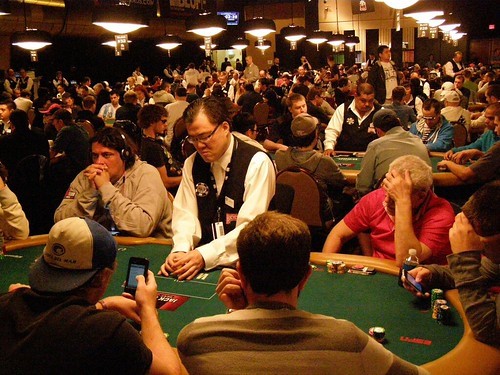Though many games from casinos have successfully made the jump into the online space, few enjoy the fame that poker does.
"Poker chips" (CC BY 2.0) by focusonmore.com
Caption: Online or off, poker remains one of the most popular games of all time
In all of its myriad forms, the humble card game is often the first thing that people think of when they consider gambling, and with good reason. With easy-to-understand rules for beginners and hard-to-master strategies for pros, poker offers a little something for everyone.
This core feature of accessibility, combined with the long legacy the game enjoys, has made it a staple in many gambling enthusiasts’ lives. The best illustration of this in the offline space is the success of poker games in enormous national and international tournaments like the World Series of Poker. In the online space similar celebrations have been held, where again the World Series of Poker reigns supreme. Peaking in October of 2020, the largest online poker tournament so far had 5,802 entries, with a total prize pool of $27.6 million.
With such shared popularity painting a developed ecosystem, players could be forgiven for thinking that offline and live online players might be one and the same. In reality, however, the offline and online divide isn’t quite so simple. Though some players do excel in both forms of the game, the functional differences between the two throw confounding variables into the mix. Taking a look at this complexity, we want to explore which aspects are similar, which are different, and why some poker games translate to the live online space easier than others.
Offline and Online Similarities
When bringing poker games to the live space, the aspects which are kept perfectly intact revolve around the mathematics of the game. This is the backbone of regular poker, on which a player’s general strategies are developed and explored. Perhaps the best and simplest example of this in action comes from how well the players can calculate odds on the fly.
We all know it’s impossible to know for sure the combinations that an opposing player can have, but by examining your hand and the cards on the table, it can be possible to narrow down options. If, for example, you have two aces in hand, and see one on the table, you know no other player could manage to beat you in a battle of three-of-a-kinds. Since all this idea requires is an understanding of the limitations of a single deck of cards, the concept will apply over all games, in person or otherwise.
A more visual similarity between the live online and offline games can come straight from the introduction of a dealer. Most often seen in professional establishments, the existence of a dedicated dealer can help foster a more serious table feel. This not only looks good, but it can also massage people into more concentrative play. Another similarity, though one which can be much trickier to manage, can be experienced through watching the performance of other players. In both live online and offline games, it can be possible to gain insight into a person’s frame of mind through subtle elements of their play. How quickly they throw down cards, how easily they fold, and how often they go all in; all these elements and more can let astute players generate a mental image of what an opponent might do next.
The Live Online/Offline Divide
The largest separation in the online and offline worlds builds on the last point, on understanding the tells of other players. The cards alone can give some indications in this regard, but offline play takes this a step further by letting players interact more directly. Seeing a person’s face, reading their body language, hearing their tone of voice: these components aren’t available in live online games. This isn’t necessarily an automatic advantage or disadvantage, depending on the player. Some players might perform better if they can read others in this manner, while others might excel when they can mask their face and voice behind a screen.

"World Series of Poker (WSOP)" (CC BY-ND 2.0) by Dittmeyer
Caption: Playing poker in person requires a different set of skills
The next standout difference takes that a step further, going into the mental game of directly manipulating your opponents. Jokes, jabs, and conversation in the offline space can again give some players a way to get into their competitor’s heads. This can lead to opponents making more mistakes, getting frustrated, or generating greater tells than they would otherwise. It’s a streamlined way to find the fish and avoid the sharks, and it’s much easier in the physical game. For players who fall into this trap, or simply dislike this aspect of poker, the live game would be preferable.
Finally, we also need to touch on the considerable divide of convenience between offline and live online poker. To play offline poker you need either to live close to a casino or other gaming club, or at least synchronize a play session with friends. Online games, by virtue of being playable at any time, avoid this issue and create a much more convenient environment.
Which Games Translate Best?
While all poker games work well in the online space, there are some which are better suited than others. Services like 888 live casino understand this, which is why some games are more commonly featured and attract more players. On this popular website, poker variants like hi-lo, stud poker, and 3 card brag are much loved, but it’s hold ’em that is by far the most popular and takes up the most tables.
There are two primary reasons for this, the first of which is the hold ’em general level of fame. The second more mechanical reason is that poker with community cards is the best suited to such a visual style of online poker. This is not only exciting for players, but it also enables more strategic play than is possible with entirely hidden cards in a game like five-card draw. In other words, some games play better to livestreaming’s strengths, which gives them an appreciable edge.

"Daydream View VR Headseet Made By Google" (CC BY 2.0) by pestoverde
Caption: VR headsets could be the next big thing in live casino gaming
With the online poker world already having come so far, it’s only natural to wonder what could come next. The general expansion of live games is a practical guarantee, but also showing potential is the integration of newer technologies like VR and AR. These systems could take live online poker to the next level, and while VR and AR systems aren’t ubiquitous yet, the latter half of the 2020s could change that. Regardless, the environment for players in all areas is better than it’s ever been, and the future is only looking brighter.

